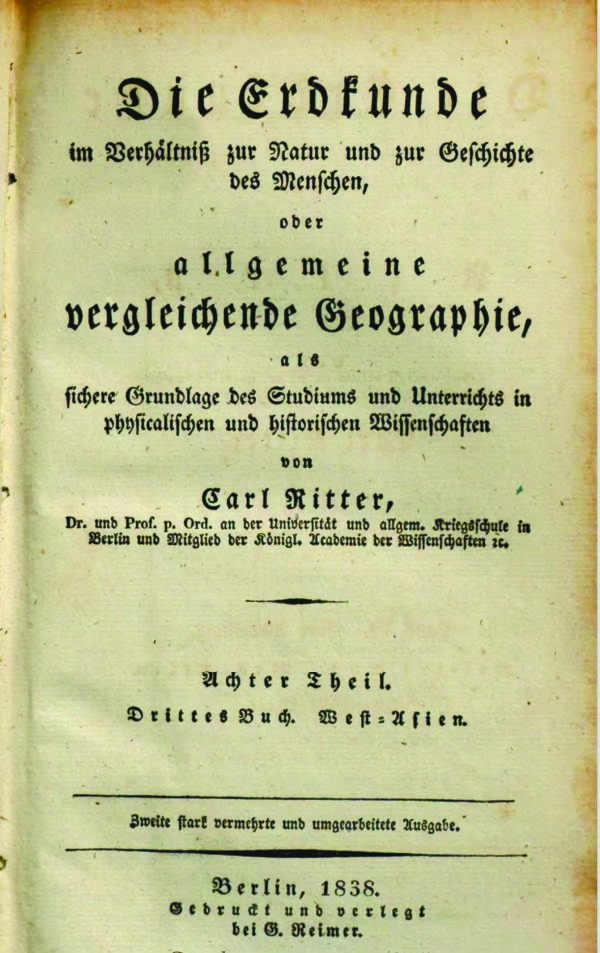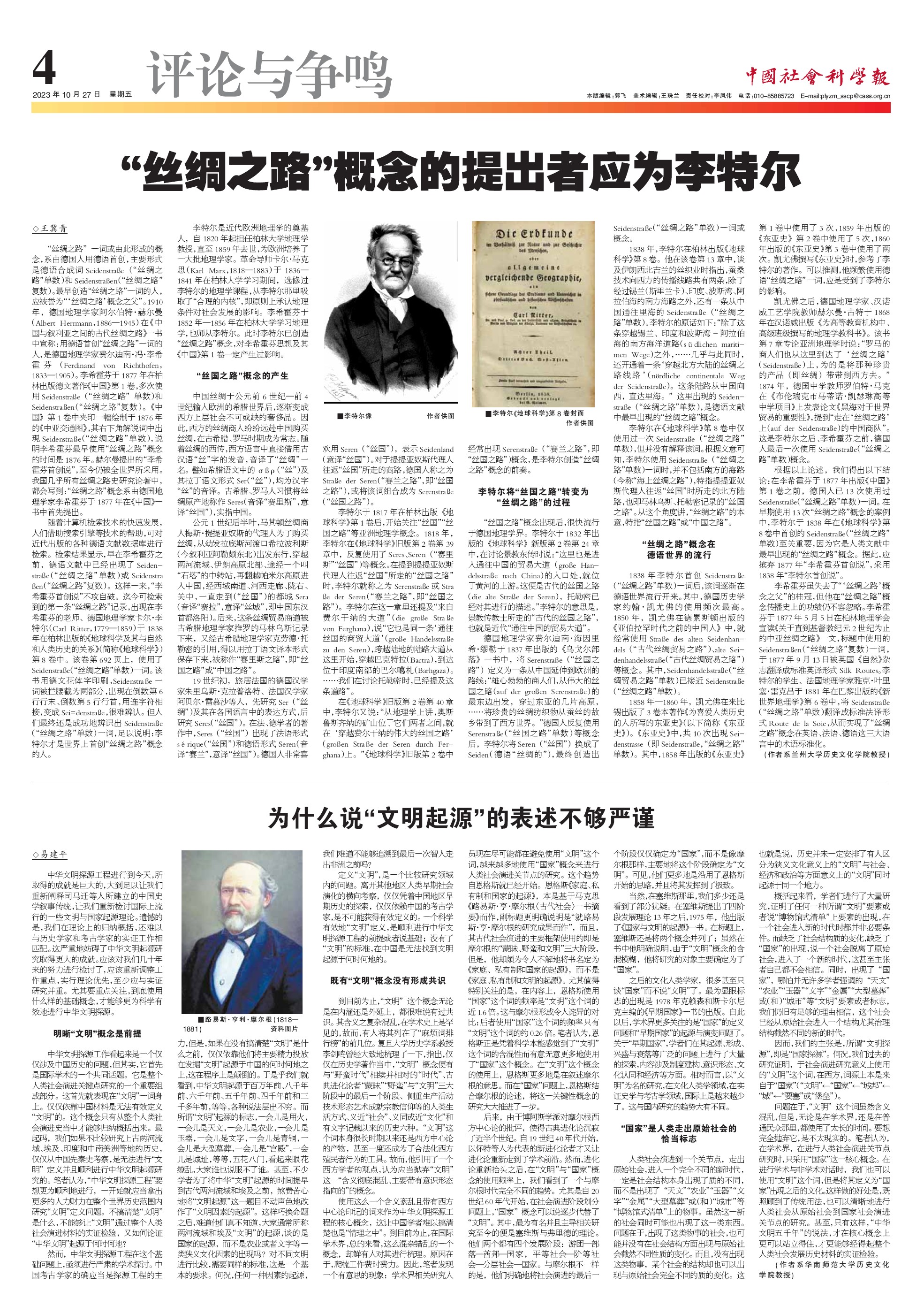
李特尔像 作者/供图
“丝绸之路”一词的概念,系由德国人用德语首创,主要形式是德语合成词 (“丝绸之路”单数)和
(“丝绸之路”单数)和 (“丝绸之路”复数)。最早创造“丝绸之路”一词的人,应被誉为“‘丝绸之路’概念之父”。1910年,德国地理学家阿尔伯特·赫尔曼(Albert Herrmann,1886—1945)在《中国与叙利亚之间的古代丝绸之路》一书中宣称:用德语首创“丝绸之路”一词的人,是德国地理学家费尔迪南·冯·李希霍芬(Ferdinand von Richthofen,1833—1905)。李希霍芬于1877年在柏林出版德文著作《中国》第1卷,多次使用
(“丝绸之路”复数)。最早创造“丝绸之路”一词的人,应被誉为“‘丝绸之路’概念之父”。1910年,德国地理学家阿尔伯特·赫尔曼(Albert Herrmann,1886—1945)在《中国与叙利亚之间的古代丝绸之路》一书中宣称:用德语首创“丝绸之路”一词的人,是德国地理学家费尔迪南·冯·李希霍芬(Ferdinand von Richthofen,1833—1905)。李希霍芬于1877年在柏林出版德文著作《中国》第1卷,多次使用 (“丝绸之路”单数)和
(“丝绸之路”单数)和 (“丝绸之路”复数)。《中国》第1卷中夹印一幅绘制于1876年的《中亚交通图》,其右下角解说词中出现
(“丝绸之路”复数)。《中国》第1卷中夹印一幅绘制于1876年的《中亚交通图》,其右下角解说词中出现 (“丝绸之路”单数),说明李希霍芬最早使用“丝绸之路”概念的时间是1876年。赫尔曼提出的“李希霍芬首创说”,至今仍被全世界所采用。我国几乎所有丝绸之路史研究论著中,都会写到“丝绸之路”概念系由德国地理学家李希霍芬于1877年在《中国》一书中首先提出。
(“丝绸之路”单数),说明李希霍芬最早使用“丝绸之路”概念的时间是1876年。赫尔曼提出的“李希霍芬首创说”,至今仍被全世界所采用。我国几乎所有丝绸之路史研究论著中,都会写到“丝绸之路”概念系由德国地理学家李希霍芬于1877年在《中国》一书中首先提出。
随着计算机检索技术的快速发展,人们借助搜索引擎等技术的帮助,可对近代出版的各种德语文献数据库进行检索。检索结果显示,早在李希霍芬之前,德语文献中已经出现了 (“丝绸之路”单数)或
(“丝绸之路”单数)或 (“丝绸之路”复数)。这样一来,“李希霍芬首创说”不攻自破。迄今可检索到的第一条“丝绸之路”记录,出现在李希霍芬的老师、德国地理学家卡尔·李特尔(Carl Ritter,1779—1859)于1838年在柏林出版的《地球科学及其与自然和人类历史的关系》(以下简称《地球科学》)第8卷中。该卷第692页上,使用了
(“丝绸之路”复数)。这样一来,“李希霍芬首创说”不攻自破。迄今可检索到的第一条“丝绸之路”记录,出现在李希霍芬的老师、德国地理学家卡尔·李特尔(Carl Ritter,1779—1859)于1838年在柏林出版的《地球科学及其与自然和人类历史的关系》(以下简称《地球科学》)第8卷中。该卷第692页上,使用了 (“丝绸之路”单数)一词。该书用德文花体字印刷,
(“丝绸之路”单数)一词。该书用德文花体字印刷, 一词被拦腰截为两部分,出现在倒数第6行行末、倒数第5行行首,用连字符相接,变成Sei=
一词被拦腰截为两部分,出现在倒数第6行行末、倒数第5行行首,用连字符相接,变成Sei= ,很难辨认。但人们最终还是成功地辨识出
,很难辨认。但人们最终还是成功地辨识出 (“丝绸之路”单数)一词,足以说明:李特尔才是世界上首创“丝绸之路”概念的人。
(“丝绸之路”单数)一词,足以说明:李特尔才是世界上首创“丝绸之路”概念的人。
李特尔是近代欧洲地理学的奠基人,自1820年起担任柏林大学地理学教授,直至1859年去世,为欧洲培养了一大批地理学家。革命导师卡尔·马克思(Karl Marx,1818—1883)于1836—1841年在柏林大学学习期间,选修过李特尔的地理学课程,从李特尔那里吸取了“合理的内核”,即原则上承认地理条件对社会发展的影响。李希霍芬于1852—1856年在柏林大学学习地理学,也师从李特尔。此时,李特尔已创造“丝绸之路”概念,对李希霍芬思想及其《中国》第1卷一定产生过影响。
“丝国之路”概念的产生
中国丝绸于公元前6世纪—前4世纪输入欧洲后,逐渐变成西方上层社会不可或缺的奢侈品。因此,西方的丝绸商人纷纷远赴中国购买丝绸,在古希腊、罗马时期成为常态。随着丝绸的西传,西方语言中直接借用古汉语“丝”字的发音,音译了“丝绸”一名。譬如,希腊语文中的 (“丝”)及其拉丁语文形式Ser(“丝”),均为汉字“丝”的音译。古希腊、罗马人习惯将丝绸原产地称作Seres(音译“赛里斯”,意译“丝国”),实指中国。
(“丝”)及其拉丁语文形式Ser(“丝”),均为汉字“丝”的音译。古希腊、罗马人习惯将丝绸原产地称作Seres(音译“赛里斯”,意译“丝国”),实指中国。
公元1世纪后半叶,马其顿丝绸商人梅斯·提提亚奴斯的代理人为了购买丝绸,从幼发拉底河渡口希拉波利斯(今叙利亚阿勒颇东北)出发东行,穿越两河流域、伊朗高原北部、途经一个叫“石塔”的中转站,再翻越帕米尔高原进入中国,经西域南道、河西走廊、陇右、关中,一直走到(“丝国”)的都城Sera(音译“赛拉”,意译“丝城”,即中国东汉首都洛阳)。后来,这条丝绸贸易商道被古希腊地理学家推罗的马林乌斯记录下来,又经古希腊地理学家克劳德·托勒密的引用,得以用拉丁语文译本形式保存下来,被称作“赛里斯之路”,即“丝国之路”或“中国之路”。
19世纪初,旅居法国的德国汉学家朱里乌斯·克拉普洛特、法国汉学家阿贝尔·雷慕沙等人,先研究Ser(“丝绸”)及其在各国语言中的表达方式,后研究Seres(“丝国”)。在法、德学者的著作中,Seres(“丝国”)出现了法语形式sérique(“丝国”)和德语形式Seren(音译“赛兰”,意译“丝国”)。德国人非常喜欢用Seren(“丝国”),表示Seidenland(意译“丝国”)。对于提提亚奴斯代理人往返“丝国”所走的商路,德国人称之为 (“赛兰之路”,即“丝国之路”),或将该词组合成为
(“赛兰之路”,即“丝国之路”),或将该词组合成为 (“丝国之路”)。
(“丝国之路”)。
李特尔于1817年在柏林出版《地球科学》第1卷后,开始关注“丝国”“丝国之路”等亚洲地理学概念。1818年,李特尔在《地球科学》旧版第2卷第39章中,反复使用了Seres、Seren(“赛里斯”“丝国”)等概念。在提到提提亚奴斯代理人往返“丝国”所走的“丝国之路”时,李特尔就称之为 或
或 (“赛兰之路”,即“丝国之路”)。李特尔在这一章里还提及“来自费尔干纳的大道”(
(“赛兰之路”,即“丝国之路”)。李特尔在这一章里还提及“来自费尔干纳的大道”(
 ),说“它也是同一条‘通往丝国的商贸大道’(
),说“它也是同一条‘通往丝国的商贸大道’(
 ),跨越陆地的陆路大道从这里开始,穿越巴克特拉(Bactra),到达位于印度南部的巴尔噶札(Barhgaza)。我们在讨论托勒密时,已经提及这条道路”。
),跨越陆地的陆路大道从这里开始,穿越巴克特拉(Bactra),到达位于印度南部的巴尔噶札(Barhgaza)。我们在讨论托勒密时,已经提及这条道路”。
在《地球科学》旧版第2卷第40章中,李特尔又说:“从地理学上讲,奥斯鲁斯齐纳的矿山位于它们两者之间,就在‘穿越费尔干纳的伟大的丝国之路’(
 )上。”《地球科学》旧版第2卷中经常出现
)上。”《地球科学》旧版第2卷中经常出现 (“赛兰之路”,即“丝国之路”)概念,是李特尔创造“丝绸之路”概念的前奏。
(“赛兰之路”,即“丝国之路”)概念,是李特尔创造“丝绸之路”概念的前奏。

李特尔《地球科学》第8卷封面 作者/供图
李特尔将“丝国之路”转变为“丝绸之路”的过程
“丝国之路”概念出现后,很快流行于德国地理学界。李特尔于1832年出版的《地球科学》新版第2卷第24章中,在讨论景教东传时说:“这里也是进入通往中国的贸易大道(
 )的入口处,就位于黄河的上游。这便是古代的丝国之路(
)的入口处,就位于黄河的上游。这便是古代的丝国之路( ),托勒密已经对其进行的描述。”李特尔的意思是,景教传教士所走的“古代的丝国之路”,也就是近代“通往中国的贸易大道”。
),托勒密已经对其进行的描述。”李特尔的意思是,景教传教士所走的“古代的丝国之路”,也就是近代“通往中国的贸易大道”。
德国地理学家费尔迪南·海因里希·缪勒于1837年出版的《乌戈尔部落》一书中,将 (“丝国之路”)定义为一条从中国延伸到欧洲的路线:“雄心勃勃的商人们,从伟大的丝国之路(
(“丝国之路”)定义为一条从中国延伸到欧洲的路线:“雄心勃勃的商人们,从伟大的丝国之路( )的最东边出发,穿过东亚的几片高原,将珍贵的丝绸纺织物从蚕丝的故乡带到了西方世界。”德国人反复使用
)的最东边出发,穿过东亚的几片高原,将珍贵的丝绸纺织物从蚕丝的故乡带到了西方世界。”德国人反复使用 (“丝国之路”单数)等概念后,李特尔将Seren(“丝国”)换成了Seiden(德语“丝绸的”),最终创造出
(“丝国之路”单数)等概念后,李特尔将Seren(“丝国”)换成了Seiden(德语“丝绸的”),最终创造出 (“丝绸之路”单数)一词或概念。
(“丝绸之路”单数)一词或概念。
1838年,李特尔在柏林出版《地球科学》第8卷。他在该卷第13章中,谈及伊朗西北吉兰的丝织业时指出,蚕桑技术向西方的传播路线共有两条,除了经过锡兰(斯里兰卡)、印度、波斯湾、阿拉伯海的南方海路之外,还有一条从中国通往里海的 (“丝绸之路”单数)。李特尔的原话如下:“除了这条穿越锡兰、印度和波斯湾—阿拉伯海的南方海洋道路(südlichen maritimen Wege)之外,……几乎与此同时,还开通着一条‘穿越北方大陆的丝绸之路线路’(
(“丝绸之路”单数)。李特尔的原话如下:“除了这条穿越锡兰、印度和波斯湾—阿拉伯海的南方海洋道路(südlichen maritimen Wege)之外,……几乎与此同时,还开通着一条‘穿越北方大陆的丝绸之路线路’(
 )。这条陆路从中国向西,直达里海。”这里出现的
)。这条陆路从中国向西,直达里海。”这里出现的 (“丝绸之路”单数),是德语文献中最早出现的“丝绸之路”概念。
(“丝绸之路”单数),是德语文献中最早出现的“丝绸之路”概念。
李特尔在《地球科学》第8卷中仅使用过一次 (“丝绸之路”单数),但并没有解释该词。根据文意可知,李特尔使用
(“丝绸之路”单数),但并没有解释该词。根据文意可知,李特尔使用 (“丝绸之路”单数)一词时,并不包括南方的海路(今称“海上丝绸之路”),特指提提亚奴斯代理人往返“丝国”时所走的北方陆路,也即马林乌斯、托勒密记录的“丝国之路”。从这个角度讲,“丝绸之路”的本意,特指“丝国之路”或“中国之路”。
(“丝绸之路”单数)一词时,并不包括南方的海路(今称“海上丝绸之路”),特指提提亚奴斯代理人往返“丝国”时所走的北方陆路,也即马林乌斯、托勒密记录的“丝国之路”。从这个角度讲,“丝绸之路”的本意,特指“丝国之路”或“中国之路”。
“丝绸之路”概念在德语世界的流行
1838年,李特尔首创 (“丝绸之路”单数)一词后,该词逐渐在德语世界流行开来。其中,德国历史学家约翰·凯尤佛的使用频次最高。1850年,凯尤佛在德累斯顿出版的《亚伯拉罕时代之前的中国人》中,就经常使用
(“丝绸之路”单数)一词后,该词逐渐在德语世界流行开来。其中,德国历史学家约翰·凯尤佛的使用频次最高。1850年,凯尤佛在德累斯顿出版的《亚伯拉罕时代之前的中国人》中,就经常使用
 (“古代丝绸贸易之路”)、
(“古代丝绸贸易之路”)、
 (“古代丝绸贸易之路”)等概念。其中,
(“古代丝绸贸易之路”)等概念。其中, (“丝绸贸易之路”单数)已接近
(“丝绸贸易之路”单数)已接近 (“丝绸之路”单数)。
(“丝绸之路”单数)。
1858—1860年,凯尤佛在来比锡出版了3卷本著作《为喜爱人类历史的人所写的东亚史》(以下简称《东亚史》)。《东亚史》中,共10次出现Seidenstrasse(即 ,“丝绸之路”单数)。其中,1858年出版的《东亚史》第1卷中使用了3次,1859年出版的《东亚史》第2卷中使用了5次,1860年出版的《东亚史》第3卷中使用了两次。凯尤佛撰写《东亚史》时,参考了李特尔的著作。可以推测,他频繁使用德语“丝绸之路”一词,应是受到了李特尔的影响。
,“丝绸之路”单数)。其中,1858年出版的《东亚史》第1卷中使用了3次,1859年出版的《东亚史》第2卷中使用了5次,1860年出版的《东亚史》第3卷中使用了两次。凯尤佛撰写《东亚史》时,参考了李特尔的著作。可以推测,他频繁使用德语“丝绸之路”一词,应是受到了李特尔的影响。
凯尤佛之后,德国地理学家、汉诺威工艺学院教师赫尔曼·古特于1868年在汉诺威出版《为高等教育机构中、高级班级撰写的地理学教科书》。该书第7章专论亚洲地理学时说:“罗马的商人们也从这里到达了‘丝绸之路’( )上,为的是将那种珍贵的产品(即丝绸)带到西方去。”1874年,德国中学教师罗伯特·马克在《布伦瑞克市马蒂诺·凯瑟琳高等中学项目》上发表论文《黑海对于世界贸易的重要性》,提到“走在‘丝绸之路’(auf der
)上,为的是将那种珍贵的产品(即丝绸)带到西方去。”1874年,德国中学教师罗伯特·马克在《布伦瑞克市马蒂诺·凯瑟琳高等中学项目》上发表论文《黑海对于世界贸易的重要性》,提到“走在‘丝绸之路’(auf der  )上的中国商队”。这是李特尔之后、李希霍芬之前,德国人最后一次使用
)上的中国商队”。这是李特尔之后、李希霍芬之前,德国人最后一次使用 (“丝绸之路”单数)概念。
(“丝绸之路”单数)概念。
根据以上论述,我们得出以下结论:在李希霍芬于1877年出版《中国》第1卷之前,德国人已13次使用过 (“丝绸之路”单数)一词。在早期使用13次“丝绸之路”概念的案例中,李特尔于1838年在《地球科学》第8卷中首创的
(“丝绸之路”单数)一词。在早期使用13次“丝绸之路”概念的案例中,李特尔于1838年在《地球科学》第8卷中首创的 (“丝绸之路”单数)至关重要,因为它是人类文献中最早出现的“丝绸之路”概念。据此,应摈弃1877年“李希霍芬首创说”,采用1838年“李特尔首创说”。
(“丝绸之路”单数)至关重要,因为它是人类文献中最早出现的“丝绸之路”概念。据此,应摈弃1877年“李希霍芬首创说”,采用1838年“李特尔首创说”。
李希霍芬虽失去了“‘丝绸之路’概念之父”的桂冠,但他在“丝绸之路”概念传播史上的功绩仍不容忽略。李希霍芬于1877年5月5日在柏林地理学会宣读《关于直到基督教纪元2世纪为止的中亚丝绸之路》一文,标题中使用的 丝绸之路”复数)一词,于1877年9月13日被英国《自然》杂志翻译成标准英译形式Silk Routes。李特尔的学生、法国地理学家雅克·叶里塞·雷克吕于1881年在巴黎出版的《新世界地理学》第6卷中,将
丝绸之路”复数)一词,于1877年9月13日被英国《自然》杂志翻译成标准英译形式Silk Routes。李特尔的学生、法国地理学家雅克·叶里塞·雷克吕于1881年在巴黎出版的《新世界地理学》第6卷中,将 (“丝绸之路”单数)翻译成标准法译形式Route de la Soie,从而实现了“丝绸之路”概念在英语、法语、德语这三大语言中的术语标准化。
(“丝绸之路”单数)翻译成标准法译形式Route de la Soie,从而实现了“丝绸之路”概念在英语、法语、德语这三大语言中的术语标准化。
(作者系兰州大学历史文化学院教授)
原文载于:《中国社会科学报》2023年10月24日第4版

相关链接:https://www.cssn.cn/skgz/bwyc/202310/t20231027_5693095.shtml



